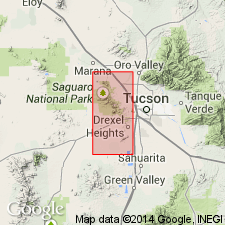
- Usage in publication:
-
- Cat Mountain rhyolite
- Modifications:
-
- Original reference
- Dominant lithology:
-
- Tuff
- AAPG geologic province:
-
- Basin-and-Range province
Summary:
Pg. 710 (fig. 2), 729-731, pl. 1. Cat Mountain rhyolite. Cliff forming series of rhyolite flows and mud flows. When fresh, rhyolites are red, and the mud flows or breccias are red or buff. Weathers dark reddish brown on steep slopes and many shades of purple, brown, buff, red, blue, and even white on more subdued slopes. Breccia at the base and tuff at the top. Thickness in Cat Mountain-Golden Gate Mountain area at least 700 to 800 feet; farther south, thickness between 200 and 300 feet. Usually rests either on overthrust mass of Cretaceous sedimentary and volcanic rocks or, where thrust has been removed by erosion, directly on truncated edges of sedimentary rock. Underlies Safford tuff (new); unconformably overlies Amole arkose (new). [Source unknown.] Age is Tertiary.
Well exposed on Cat Mountain and Golden Gate Mountain [Cat Mountain 7.5-min quadrangle, Pima Co., southeastern AZ]. Most conspicuous and one of the most widespread formations in Tucson Mountains, Pima Co., southeastern AZ.
Source: US geologic names lexicon (USGS Bull. 1200, p. 675).
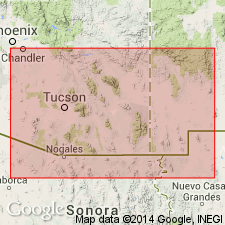
- Usage in publication:
-
- Cat Mountain Rhyolite*
- Modifications:
-
- Overview
- AAPG geologic province:
-
- Basin-and-Range province
Summary:
Is youngest Cretaceous formation in Tucson Mountains (Pima Co, AZ) in Basin-and-Range province. Overlies Tucson Mountain Chaos (Campanian) of Kinnison (1959) with apparent conformity. Is a welded tuff unit, at least 800 ft thick. Is correlated with lithologically similar welded tuff member of Salero Formation on basis of radiometric dating. Age is shown to be Campanian and Maestrichtian (Late Cretaceous) on correlation chart (fig. 5).
Source: GNU records (USGS DDS-6; Denver GNULEX).
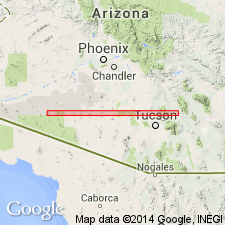
- Usage in publication:
-
- Cat Mountain Tuff*
- Modifications:
-
- Areal extent
- Overview
- AAPG geologic province:
-
- Basin-and-Range province
Summary:
Extended into Silver Bell Mountains, Pima Co, AZ, Basin-and-Range province. Rocks previously called tuff of Mount Lord Volcanics by author in unpublished dissertation (1987, Univ. of Calif., Santa Barbara). Consists of eutaxitic rhyolite welded tuff about 200 m thick and makes up all high peaks of central Silver Bell Mountains. Cat Mountain was erupted from Tucson Mountains caldera. Overlies Silver Bell Volcanics; is youngest Upper Cretaceous unit. Geologic map.
Source: GNU records (USGS DDS-6; Denver GNULEX).
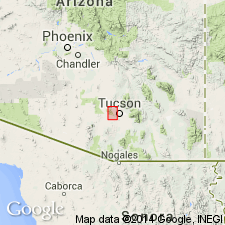
- Usage in publication:
-
- Cat Mountain Tuff*
- Modifications:
-
- Redescribed
- Paleomagnetics
- Dominant lithology:
-
- Tuff
- AAPG geologic province:
-
- Basin-and-Range province
Summary:
Name changed from Cat Mountain Rhyolite to Cat Mountain Tuff. Described as a rhyolitic tuff. Erupted about 72 Ma from a caldera in the Tucson Mountains of southern AZ in the Basin-and-Range province. Is a single, thick, intra caldera ash-flow sheet with complex welding variations. Has two paleomagnetically defined cooling units in the Tucson Mountains. The lower magnetic unit caps the Silver Bell Mountains. The lower unit shows a 19 deg +/-3 deg clockwise rotation of the Silver Bell Mountains relative to the Tucson Mountains. Paleomagnetic directions on tuff of Confidence Peak and upper tuff indicate Roskruge Mountains were rotated 28 deg +/-21 deg relative to North America between emplacement of the two tuffs and were rotated counterclockwise after emplacement of the Cat Mountain Tuff. The resurgent Amole pluton was emplaced soon after the Cat Mountain. Cretaceous age. Geologic Map of Tucson Mountains.
Source: GNU records (USGS DDS-6; Denver GNULEX).
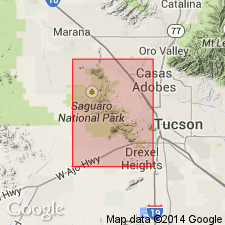
- Usage in publication:
-
- Cat Mountain Tuff*
- Modifications:
-
- Revised
- Overview
- Geochronologic dating
- AAPG geologic province:
-
- Basin-and-Range province
Summary:
Mapped in Tucson Mountains, Pima Co, AZ, Basin-and-Range province; is thick intracaldera compound cooling unit of rhyolitic ash-flow tuff with variable welding and crystallization character; interfingers complexly with chaotic megabreccia. Thickness ranges from 100 m in southern Tucson Mountains (hinged sag of caldera) to at least 4-5 km in northern part of range (area of maximum subsidence of caldera); thickness variations indicate trap-door collapse of Tucson Mountains caldera. Divided into five units: densely welded rhyolite, partly welded rhyolite, nonwelded to partly welded rhyolite, megabreccia member, and intrusive rhyolitic tuff. Densely welded rhyolite is main cliff-forming unit in Tucson Mountains. Amole latite of Brown (1939, GSA Bull., v. 50, p. 697-760) abandoned and rocks assigned to nonwelded to partly welded rhyolite unit. Tucson Mountain chaos of Kinnison (1959, AZ Geol. Soc. Guidebook II, p.48-57) abandoned and rocks assigned to megabreccia member. Megabreccia member, consisting of 7 subunits based on dominant clast type, represents synvolcanic landslide deposits derived from walls of Tucson Mountain caldera during ash-flow eruptions and caldera collapse; individual megablocks are up to several hundred m across. Overlies precaldera Cretaceous rocks; older than postcollapse intrusions and caldera-filling lavas and sedimentary rocks. K-Ar feldspar age is 72-68 Ma; 40Ar/39Ar biotite age is 73.1 Ma (Late Cretaceous).
Source: GNU records (USGS DDS-6; Denver GNULEX).
For more information, please contact Nancy Stamm, Geologic Names Committee Secretary.
Asterisk (*) indicates published by U.S. Geological Survey authors.
"No current usage" (†) implies that a name has been abandoned or has fallen into disuse. Former usage and, if known, replacement name given in parentheses ( ).
Slash (/) indicates name conflicts with nomenclatural guidelines (CSN, 1933; ACSN, 1961, 1970; NACSN, 1983, 2005, 2021). May be explained within brackets ([ ]).

